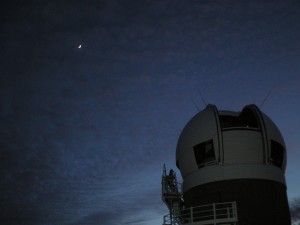Our own galaxy, the Milky Way, or its sister, the Andromeda galaxy, are large spiral galaxies, whose stars are mainly harbored in beautiful disks (which provide the white for the back-to-back fried egg picture of a galaxy) and bulges (which constitute the yolk). They are also surrounded by a stellar ‘halo’, a diffuse envelope of stars that extends out to regions five to ten times farther than the disk, and embedded in an even larger and very massive dark matter halo which can only be seen due to its gravitational influence. In this halo, a few tens of satellite dwarf galaxies, such as the famous Magellanic Clouds, surround us.
But how did these galaxies form? In the currently favored cosmology, the Universe is dominated by Cold Dark Matter (dark matter particles which move slowly) and galaxies are shaped over time from the successive absorption of smaller satellite galaxies, attracted by gravity. Although most of the matter is in the form of the elusive dark matter, baryons (the visible matter, including stars and gas, you and I) preserve the imprint of the past and current hierarchical formation in the outer regions of galaxies.

The moon rising behing the Pan-STARRS1 telescope. Credit: JD Armstrong
These last few decades have shown that this theoretical framework is highly successful and can replicate the distribution of galaxies and galaxy clusters in the universe. It also produces accurate predictions on hierarchical merging on small scales; scales that can only be tested within our group of galaxies (the Local Group), where the structured nature of stellar halos, for instance, can be perceived with enough detail. However, at this level, the picture provided by the theory shows uncertainties, and even apparent mismatches, with observations of our surroundings. This indicates that our understanding of the cosmological model and its observational consequences is not yet complete.
The sensitive, large-scale survey produced by the Pan-STARRS1 telescope provides an ever-expanding level of information from our surroundings. It leads to an exciting time where the exquisite detail that is obtained on the Local Group of galaxies can be used as a probe to constrain the cosmology. This is the basis of one of the 12 science Key Projects identified by the Pan-STARRS 1 Science Consortium.
Its systematic mapping of the structure of the Milky Way, and in particular of its disk, an area usually avoided by astronomers given the complexity of mapping these dense and dusty regions. With the observations of hundreds of millions of Milky Way stars, we will be able to provide a good description of the shape of the disk of our Galaxy. Is a smooth model even warranted, or is the disk distorted and clumpy?
PS1′s depth will allow us to map the faint and elusive stellar halo of the Milky Way, these regions that extend over tens of thousands of lightyears, sparsely populated in stars, but that keep the imprint of the cannibalistic behavior of our Galaxy. This is where we can find coherent streams of stars, remnants of dwarf galaxies that came too close to the Milky Way and got shredded apart by its tidal forces. These are the signposts of the “hierarchical” assembly predicted by the theory.
The survey’s homogeneous coverage of the night sky will give us a unique opportunity to find the faintest galaxies ever found: very small dwarf galaxies that orbit around the Milky Way and the Andromeda galaxy. These small clumps of dark matter host but a few hundreds of stars which can be, overall, less bright that a single giant star! Understanding how stars have formed in these dimmest of galaxies is essential to test the theory since, through hierarchical formation, they are at the base of all the brighter galaxies.
With the dawn of the Pan-STARRS 1 survey, we are in a unique position to map our own group of galaxies, our cosmic backyard, with a level of detail never achieved before for any galaxy. This will allow us to test the tenets of the cosmological model, as well as piece together the faint limit of what a galaxy is.


